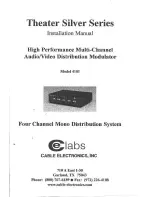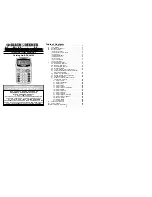
The package is a collection of programs which will be useful to students and teachers, mostly in
calculus classes or courses where calculus is used. Once the package is loaded, the programs and
functions basically become part of the calculator firmware.
Here are the programs (functions) and a comment about each:
Tangent Line and Normal Line:
These two functions compute the equations of the respective lines, given a function and a value of the
independent variable. Each then displays a graph of the function and the respective line. This will be
useful to teachers while teaching the derivative concept and to students to check their understanding
and their homework.
Newton’s Method:
For a given function and an initial guess of the independent variable, the graph of the function and
successive tangent lines which estimate a zero of the function are drawn. This is nice to illustrate the
Method and possibly to find a zero of a function, though there are better methods built in to the
calculator. I use this to introduce Newton’s Method, though.
Implicit Derivative:
This finds dy/dx given f(x,y)=0. Useful to students, but most teachers will prefer to use a method which
shows the steps and concepts involved. The practical use of this function is that it will find nth
derivatives implicitly, a topic which is often slighted and rarely mastered in the first course.
Curvature, Center of Curvature, and Osculating Circle:
These do the computations for any function and will be useful to teacher and student while studying
these topics. The answers are given “for any x”, not just for specified values of the independent
variable.Thus, it is easy to explore the local behavior of a curve in 2-space and related topics of
geometry such as the evolute.
The section on integration will be very useful at the outset of learning about the definite integral. It
contains functions to display the graph of a chosen function on a chosen interval, together with a
selected number of “approximating panels” using any of the midpoint, left-hand, right-hand, trapezoidal,
or Simpson’s Rule. Also, there is an option to display the Riemann sums for all methods on the same
screen. Armed with the right examples, there is plenty here to clarify the teaching and understanding of
the limit of such sums.
A function is included which performs the ratio test for infinite series, given a formula for the general
term. Two other functions included here are not traditional calculus topics., They find the sum of either
first order or second order difference equations, given the expression of the general term. In a course
where discrete methods or dynamical systems are explored, these could be very useful.
Computation of four functions, the gradient, divergence, curl, and potential function, which are studied
in vector calculus is included. As is the case with all the functions of this package, these may be called
during the regular use of the calculator without previously entering the Calculus Tools menu. This
substantially extends the usefulness of the calculator.
There are eight “Advanced” mathematical functions included. The error function, erf(), and the
complementary error function, erfc(), will be useful in statistics applications, but these are also included
in another free downloadable FlashWare application which duplicates the statistics functions on the
TI-83. In fact, the function TIStat.normCdf() seems to be somewhat more accurate than CalcTool.erf().
6 - 89
Содержание TI-92+
Страница 52: ...Component side of PCB GraphLink I O connector detail 1 41...
Страница 53: ...LCD connector detail PCB switch side 1 42...
Страница 54: ...Key pad sheet contact side Key pad sheet key side 1 43...
Страница 55: ...Key cap detail 1 44...
Страница 57: ...Component side of PCB with shield removed A detail view of the intergrated circuits 1 46...
Страница 59: ...Keypad rubber sheet key cap side Inside front cover showing keycaps in place Detail of a key cap 1 48...
Страница 410: ...void extensionroutine2 void Credit to Bhuvanesh Bhatt 10 4...














































